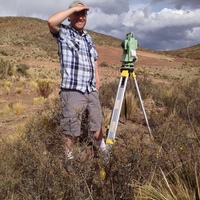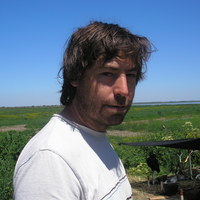
José Capriles
Phone: +1-814-880-3327
Address: 314 Carpenter Building
Department of Anthropology
The Pennsylvania State University
University Park, PA 16802
Address: 314 Carpenter Building
Department of Anthropology
The Pennsylvania State University
University Park, PA 16802
less
Related Authors
Milagros Colobig
CICYTTP-CONICET
María Agustina Ramos van Raap
Universidad Nacional de La Plata
Mariano Bonomo
Universidad Nacional de La Plata
Violeta Di Prado
Universidad Nacional de La Plata
Gustavo Politis
National Scientific and Technical Research Council
Domingo Carlos Salazar-García
University of Cape Town
Irina Capdepont
Universidad de la República
Gustavo Politis
Universidad del Centro de la Provincia de Buenos Aires
InterestsView All (39)










Uploads
Papers by José Capriles
humans that reached them during the late Pleistocene. Based on previous research, and aided by human behavioral ecology principles, we assess hunter-gatherer behavioral strategies in the Andean highlands during the late Pleistocene and early Holocene. Specifically, we formulate three mobility strategies and their archaeological expectations and test these using technological and subsistence evidence from the six earliest well-dated highland sites in northern Chile. Our results
suggest that all of the studied sites were temporarily occupied for hunting, processing animals, and toolkit maintenance. The sites also exhibit shared technological features within a curatorial strategy
albeit with different occupation intensities. From this evidence, we infer that the initial occupations of the highlands were logistical and probably facilitated by increased local resource availability during a period of environmental amelioration.
We present sighting data of the Rufous-throated Dipper (Cinclus schulzi) in Cordillera de Sama, Tarija Department, Bolivia. We visited 17 rivers and streams, but we attained only 12 sightings in 4 water courses, corresponding to a minimum of 10 individuals: 4 pairs, a solitary individual and a fledging. Dippers were recorded in clear water courses, but were absent in sites contaminated with livestock waste. We confirm the presence of Cinclus schulzi in the Cordillera de Sama Biological Reserve and its nesting in the area. Furthermore, we present data about
foraging behaviour and interactions with other species.
Se presentan datos de avistamientos del Mirlo de Agua de Barba Roja (Cinclus schulzi) en la Cordillera de Sama, departamento de Tarija, Bolivia. Se recorrieron 17 quebradas, arroyos y ríos, pero solamente se realizaron 12 avistamientos en 4 cursos de agua, correspondientes a un mínimo de 10 individuos: 4 parejas, un individuo solitario y un volantón. Los mirlos fueron registrados en cursos de aguas claras, pero estaban ausentes en las porciones de los ríos contaminados con residuos de ganado. Se confirma la presencia de Cinclus schulzi en la Reserva Biológica Cordillera de Sama y su nidificación en el área. Además, se presentan datos sobre el comportamiento de alimentación y la interacción con otras especies.
During the Middle Horizon (500-1100 AD) the south central Andes were the scenario of the formation, development, and collapse of the Tiwanaku state. Although there is considerable debate about the political implications and the effective control of its periphery, religious ideology and interregional exchange were apparently, two very important aspects of the hegemonic dynamics of Tiwanaku. On the one hand, the nature of Tiwanaku religious system has been primarily focused through monumental architecture, funerary patterns and iconography in different finely crafted objects. On the other hand, the interpretation of economic exchange have been addressed from the presence of archaeological remains from distant places in the ceremonial core as well as by the presence of Tiwanaku materials in the nuclear area from distant settlements. In this paper, based on the contextual description of an archaeological discovery made in the highlands of Lípez, we discuss some hypotheses regarding changes in the ritual system and social interaction near the end of the Middle Horizon. We conclude that the Tiwanaku hegemony effectively promoted a ritual and social interaction that facilitated the transmission of their ideological foundation, which, however, changed radically as the political disintegration of the state occurred during the eleventh century.
CHARLES STANISH, CECILIA CHÁVEZ JUSTO,
KARL LAFAVRE, and AIMÉE PLOURDE. 2014.
Memoirs of the Museum of Anthropology Number 56,
Studies in Latin American Ethnohistory & Archaeology
Volume IX. University of Michigan, Ann Arbor. xvi +
407 pp. $38.00 (paper), ISBN 978-0-915703-84-5.
this time to relinquish the former Tiwanaku ritual practices that its contents represent.
humans that reached them during the late Pleistocene. Based on previous research, and aided by human behavioral ecology principles, we assess hunter-gatherer behavioral strategies in the Andean highlands during the late Pleistocene and early Holocene. Specifically, we formulate three mobility strategies and their archaeological expectations and test these using technological and subsistence evidence from the six earliest well-dated highland sites in northern Chile. Our results
suggest that all of the studied sites were temporarily occupied for hunting, processing animals, and toolkit maintenance. The sites also exhibit shared technological features within a curatorial strategy
albeit with different occupation intensities. From this evidence, we infer that the initial occupations of the highlands were logistical and probably facilitated by increased local resource availability during a period of environmental amelioration.
We present sighting data of the Rufous-throated Dipper (Cinclus schulzi) in Cordillera de Sama, Tarija Department, Bolivia. We visited 17 rivers and streams, but we attained only 12 sightings in 4 water courses, corresponding to a minimum of 10 individuals: 4 pairs, a solitary individual and a fledging. Dippers were recorded in clear water courses, but were absent in sites contaminated with livestock waste. We confirm the presence of Cinclus schulzi in the Cordillera de Sama Biological Reserve and its nesting in the area. Furthermore, we present data about
foraging behaviour and interactions with other species.
Se presentan datos de avistamientos del Mirlo de Agua de Barba Roja (Cinclus schulzi) en la Cordillera de Sama, departamento de Tarija, Bolivia. Se recorrieron 17 quebradas, arroyos y ríos, pero solamente se realizaron 12 avistamientos en 4 cursos de agua, correspondientes a un mínimo de 10 individuos: 4 parejas, un individuo solitario y un volantón. Los mirlos fueron registrados en cursos de aguas claras, pero estaban ausentes en las porciones de los ríos contaminados con residuos de ganado. Se confirma la presencia de Cinclus schulzi en la Reserva Biológica Cordillera de Sama y su nidificación en el área. Además, se presentan datos sobre el comportamiento de alimentación y la interacción con otras especies.
During the Middle Horizon (500-1100 AD) the south central Andes were the scenario of the formation, development, and collapse of the Tiwanaku state. Although there is considerable debate about the political implications and the effective control of its periphery, religious ideology and interregional exchange were apparently, two very important aspects of the hegemonic dynamics of Tiwanaku. On the one hand, the nature of Tiwanaku religious system has been primarily focused through monumental architecture, funerary patterns and iconography in different finely crafted objects. On the other hand, the interpretation of economic exchange have been addressed from the presence of archaeological remains from distant places in the ceremonial core as well as by the presence of Tiwanaku materials in the nuclear area from distant settlements. In this paper, based on the contextual description of an archaeological discovery made in the highlands of Lípez, we discuss some hypotheses regarding changes in the ritual system and social interaction near the end of the Middle Horizon. We conclude that the Tiwanaku hegemony effectively promoted a ritual and social interaction that facilitated the transmission of their ideological foundation, which, however, changed radically as the political disintegration of the state occurred during the eleventh century.
CHARLES STANISH, CECILIA CHÁVEZ JUSTO,
KARL LAFAVRE, and AIMÉE PLOURDE. 2014.
Memoirs of the Museum of Anthropology Number 56,
Studies in Latin American Ethnohistory & Archaeology
Volume IX. University of Michigan, Ann Arbor. xvi +
407 pp. $38.00 (paper), ISBN 978-0-915703-84-5.
this time to relinquish the former Tiwanaku ritual practices that its contents represent.
Wankarani is among the most often cited examples of an early herding society in the Andes. Nevertheless, to date, there has not been an archaeologically-oriented study, focused on exploring the characteristics of Wankarani economy and faunal use. The goal of this study is to improve our current understanding of the nature and development of early camelid pastoralism in the Andean highlands by testing a set of hypotheses related to the Wankarani cultural complex and the characterization of the economic organization of the central alitplano before, during, and following the Formative Period. The studied datasets include settlement patterns, site layouts, and artifact and ecofact analysis, emphasizing faunal remains. The results of the project include a summary of 185 sites identified during survey, the excavation of eight occupation levels from five different settlements, and the analysis of over 43,000 bone specimens. Using relational analogies derived from ethnographic and ethnoarchaeological research on Andean pastoralists, and tested with descriptive and quantitative analyses of archaeological data (and particularly faunal remains), I suggest that the Formative Period of the central altiplano was occupied by communities of mobile camelid pastoralists who also practiced a number of other complementary practices such as fishing, hunting wild fauna, and cultivating quinoa and tubers. Although this subsistence system continued largely unmodified for centuries, the incorporation of the central altiplano into the Tiwanaku state around AD 500, produced structural changes that included amplified inter-regional caravan exchange and increased reliance on cultivation. This assessment is consistent with current interpretations of other early pastoralist societies that have benefited from improved anthropological research and better explanatory models.
Entender las razones y las consecuencias de la domesticación y el desarrollo de sistemas especializados de agricultura ha sido un objetivo fundamental de la investigación antropológica. La domesticación de los camélidos sudamericanos (llamas y alpacas) transformó el uso del paisaje andino con el desarrollo de sociedades pastoriles especializadas. En el altiplano central de Bolivia, durante el Período Formativo (1500 a.C. - 500 d.C.) un complejo cultural conocido como
Wankarani se desarrolló. Wankarani es uno de los ejemplos más citados como sociedad de pastoreo temprana en los Andes. Sin embargo, hasta la fecha, no ha habido un estudio arqueológico orientado a explicar las características de la economía y la utilización de fauna Wankarani. El objetivo de esta investigación es mejorar la comprensión actual de la naturaleza y el desarrollo del pastoreo temprano camélidos en el altiplano andino evaluando una serie de hipótesis relacionadas con el complejo cultural Wankarani y la caracterización de la organización económica en el altiplano central antes, durante y después del Período Formativo. Los conjuntos de datos estudiados incluyen patrones de asentamiento, estructura de sitios, y el análisis de artefactos y ecofactos, destacando los restos de fauna. Los resultados del proyecto incluyen el resumen de 185 sitios identificados durante la prospección, la excavación de ocho niveles de ocupación en cinco asentamientos diferentes, y el análisis de más de 43.000 especímenes óseos. Utilizando analogías relacionales derivadas de investigaciones etnográficas y etnoarqueológicas de pastores andinos, y basado en análisis descriptivos y cuantitativos de los datos arqueológicos (y en particular los restos de fauna), sugiero que durante el Período Formativo
el altiplano central fue ocupado por comunidades de pastores de camélidos móviles que también practicaron una serie de otras actividades complementarias como la pesca, la caza de fauna silvestre y el cultivo de la quinua y tubérculos. Aunque este sistema de subsistencia permaneció en gran medida sin modificarse durante hace siglos, la incorporación del altiplano central al estado de Tiwanaku alrededor del año 500 d.C., produjo cambios estructurales que incluyeron la amplificación del intercambio caravanero interregional y una creciente dependencia en la agricultura. Esta evaluación es coherente con las interpretaciones actuales de otras sociedades pastoriles tempranas que se han beneficiado de una mejor investigación antropológica y mejores modelos explicativos.